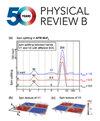Observable-enriched entanglement
IF 3.7
2区 物理与天体物理
Q1 Physics and Astronomy
引用次数: 0
Abstract
We introduce methods of characterizing entanglement on the example of the quantum skyrmion Hall effect, in which entanglement measures are enriched by the matrix representations of operators for observables. These observable operator matrix representations can enrich the partial trace over subsets of a system's degrees of freedom, yielding reduced density matrices useful in computing various measures of entanglement, which also preserve the observable expectation value. We focus here on applying these methods to compute entanglement spectra, unveiling bulk-boundary correspondences of canonical four-band models for topological skyrmion phases and their connection to simpler forms of bulk-boundary correspondence. Given the fundamental roles entanglement signatures and observables play in the study of quantum systems and the fundamental generalization of the interpretation and treatment of spin within the framework of the quantum skyrmion Hall effect, concepts of observable-enriched entanglement introduced here are broadly applicable to myriad problems of quantum systems.可观测的丰富纠缠
我们以量子斯基米子霍尔效应为例,介绍了表征纠缠的方法,其中纠缠度量通过可观测值算子的矩阵表示来丰富。这些可观测算子矩阵表示可以丰富系统自由度子集上的部分迹线,产生可用于计算各种纠缠度量的简化密度矩阵,这也保留了可观测的期望值。我们在这里着重于应用这些方法来计算纠缠谱,揭示拓扑skyrmion相的规范四波段模型的体边界对应,以及它们与更简单形式的体边界对应的联系。考虑到纠缠特征和可观测值在量子系统研究中的基本作用,以及在量子斯基米子霍尔效应的框架内对自旋的解释和处理的基本推广,本文引入的富观测纠缠的概念广泛适用于量子系统的无数问题。2025年由美国物理学会出版
本文章由计算机程序翻译,如有差异,请以英文原文为准。
求助全文
约1分钟内获得全文
求助全文
来源期刊

Physical Review B
物理-物理:凝聚态物理
CiteScore
6.70
自引率
32.40%
发文量
0
审稿时长
3.0 months
期刊介绍:
Physical Review B (PRB) is the world’s largest dedicated physics journal, publishing approximately 100 new, high-quality papers each week. The most highly cited journal in condensed matter physics, PRB provides outstanding depth and breadth of coverage, combined with unrivaled context and background for ongoing research by scientists worldwide.
PRB covers the full range of condensed matter, materials physics, and related subfields, including:
-Structure and phase transitions
-Ferroelectrics and multiferroics
-Disordered systems and alloys
-Magnetism
-Superconductivity
-Electronic structure, photonics, and metamaterials
-Semiconductors and mesoscopic systems
-Surfaces, nanoscience, and two-dimensional materials
-Topological states of matter
 求助内容:
求助内容: 应助结果提醒方式:
应助结果提醒方式:


